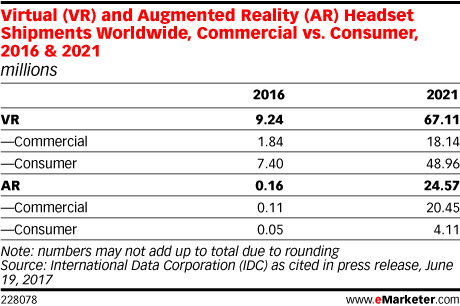
VR has outpaced AR in terms of headset shipments. And that trend will continue through 2021 projects IDC. Of course we’re talking about headsets as opposed to smartphone-based VR/AR which will scale to greater levels in the near term, as we’ve examined.
IDC also looked at commercial versus consumer headsets, showing AR will exceed with the former, and VR with the latter. That follows logic, and our past analysis, due to AR’s natural integrations with heads-up enterprise use (think: manufacturing and assembly).

But it should be noted that these figures examine sheer unit sales of headsets. Another dimension of data should be explored: active use. And there we believe AR will eclipse VR, due to it’s enablement through a greater portion of the day.
In other words, VR’s greater immersion is a double edged sword. It creates more graphically rich experiences — great for gaming and entertainment — but also a degree of isolation that precludes daily activity like walking around and interacting with the world.
That factor will ultimately give AR the edge when it comes to not only volume of use per day, but applicability to a wider range of daily activity. That means everything from social interaction to working, commuting and not wandering into construction sites.
To that end, eMarketer projects 54.4 million AR users by 2019. ARtillry believes these figures are defensible, however the majority of that use will be mobile AR. Headset AR conversely will not reach these levels (one sixth of the US population) in two short years.

For a deeper dive on AR & VR insights, subscribe to ARtillry Intelligence Briefings, and sign up for the free ARtillry Weekly newsletter.
Disclosure: ARtillry has no financial stake in the companies mentioned in this post, nor received payment for its production. Disclosure and ethics policy can be seen here.
